Sony CMT-EX1 User Manual

3-867-450-13(1)
Compact
Component
System
Operating Instructions
Owner’s Record
The model and serial numbers are located on the rear of the system. Record the serial number in the space provided below. Refer to them whenever you call upon your Sony dealer regarding this product.
|
|
Model No. |
|
Serial No. |
|
|
|
|
|
|
|
|
|
|
CMT-EX1
©1999 Sony Corporation

WARNING
To prevent fire or shock hazard, do not expose the unit to rain or moisture.
To avoid electrical shock, do not open the cabinet. Refer servicing to qualified personnel only.
Do not install the appliance in a confined space, such as a bookcase or built-in cabinet.
This appliance is classified as a CLASS 1 LASER product. The CLASS 1 LASER PRODUCT MARKING is located on the bottom exterior.
Except for North American model:
The following caution label is located inside the unit.
NOTICE FOR THE CUSTOMERS IN THE U.S.A.
This symbol is intended to alert the user to the presence of uninsulated “dangerous voltage” within the product’s enclosure that may be of sufficient magnitude to constitute a risk of electric shock to persons.
This symbol is intended to alert the user to the presence of important operating and maintenance (servicing) instructions in the literature accompanying the appliance.
CAUTION
The use of optical instruments with this product will increase eye hazard.
The shielded interface cable recommended in this manual must be used with this equipment in order to comply with limits for a digital device pursuant to Subpart B of Part 15 FCC Rules.
INFORMATION
This equipment has been tested and found to comply with the limits for a Class B digital device, pursuant to Part 15 of the FCC Rules. These limits are designed to provide reasonable protection against harmful interference in a residential installation. This equipment generates, uses, and can radiate radio frequency energy and, if not installed and used in accordance with the instructions, may cause harmful interference to radio communications. However, there is no guarantee that interference will not occur in a particular installation. If this equipment does cause harmful interference to radio or television reception, which can be determined by turning the equipment off and on, the user is encouraged to try to correct the interference by one or more of the following measures:
–Reorient or relocate the receiving antenna.
–Increase the separation between the equipment and receiver.
–Connect the equipment into an outlet on a circuit different from that to which the receiver is connected.
–Consult the dealer or an experienced radio/TV technician for help.
CAUTION
You are cautioned that any changes or modifications not expressly approved in this manual could void your authority to operate this equipment.
Note to CATV system installer:
This reminder is provided to call CATV system installer’s attention to Article 820–40 of the NEC that provides guidelines for proper grounding and, in particular, specifies that the cable ground shall be connected to the grounding system of the building, as close to the point of cable entry as practical.
NOTICE FOR THE CUSTOMERS IN CANADA
CAUTION:
TO PREVENT ELECTRIC SHOCK, DO NOT USE THIS POLARIZED AC PLUG WITH AN EXTENSION CORD, RECEPTACLE OR OTHER OUTLET UNLESS THE BLADES CAN BE FULLY INSERTED TO PREVENT BLADE EXPOSURE.
2

Table of Contents |
|
Getting Started |
|
Step 1: Hooking up the system ................ |
4 |
Step 2: Setting the time ............................ |
6 |
Step 3: Presetting radio stations ............... |
7 |
Saving the power in standby mode ........... |
8 |
Optional Components |
|
Connecting audio components ................ |
20 |
Listening to the sound of connected |
|
components ....................................... |
21 |
Recording a CD on an MD/a tape ........... |
22 |
Connecting external antennas ................. |
22 |
Basic Operations |
|
Playing a CD ............................................. |
9 |
Listening to the radio .............................. |
10 |
The CD Player |
|
Playing the CD tracks in random order |
|
–– Shuffle Play ................................. |
12 |
Programing the CD tracks |
|
–– Program Play ............................... |
13 |
Playing the CD tracks repeatedly |
|
–– Repeat Play .................................. |
14 |
Using the CD display .............................. |
15 |
Other Features |
|
Generating a more dynamic sound .......... |
16 |
Selecting the surround effect ................... |
16 |
Using the Radio Data System (RDS) |
|
(European model only) ..................... |
17 |
Falling asleep to music |
|
— Sleep Timer ................................. |
17 |
Waking up to music |
|
— Daily Timer ................................. |
18 |
Additional Information
Precautions .............................................. |
23 |
Troubleshooting ...................................... |
24 |
Specifications .......................................... |
26 |
Index ........................................... |
back cover |
3
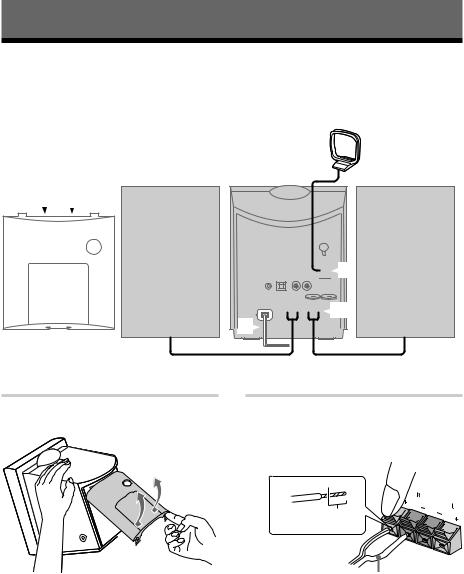
Getting Started
Step 1: Hooking up the system
Perform the following procedures 1to 5to hook up your system using the supplied cords and accessories.
The front cover is made of tempered glass. Please remember to handle this unit carefully.
AM loop antenna
Rear cover |
Right speaker |
Left speaker |
1 4



 3
3
 2
2
5
1 Remove the rear cover. |
2 Connect the speakers. |
Push in on the tabs and pull up the cover
Connect the speaker cords to the SPEAKER terminals as shown below.
Insert this portion
lined 
clear
Notes
•Keep the speaker cords away from the antenna to prevent noise.
•Be sure to connect both left and right speakers. Otherwise, the sound will not be heard.
4
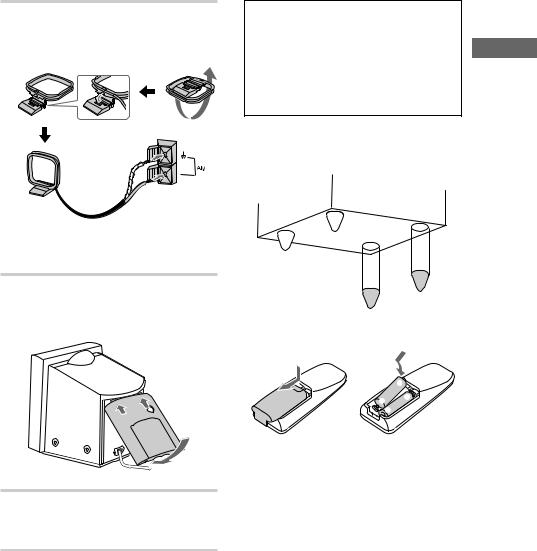
3Connect the AM antenna.
Set up the AM loop antenna, then connect it. Connect the white cord to the U terminal, and the red cord to the other terminal.
 AM loop antenna
AM loop antenna
Note
Keep the antenna away from the speaker cords to prevent noise.
4Reinstall the rear cover.
Put the wires through the hole at the bottom of the rear cover.
5Connect the AC power cord to a wall outlet after you complete all the connections.
Note on the glass cover of CD player
The CD player cover is made of tempered glass. Under normal conditions, this tempered glass is more shock resistant and able to bear more weight than ordinary glass. This glass, however, may shatter if it receives a sharp blow or if it is scratched.
To level the speakers
Attach the supplied speaker legs to the rear of the speaker bottoms to level the speakers.
Inserting two R6 (size AA) batteries into the remote
e
E E
 e
e
Tip
With normal use, the batteries should last for about six months. When the remote no longer operates the system, replace both batteries with new ones.
Note
If you do not use the remote for a long period of time, remove the batteries to avoid possible damage from battery leakage.
To connect optional component
See “Optional Components” on page 20.
Started Getting
5
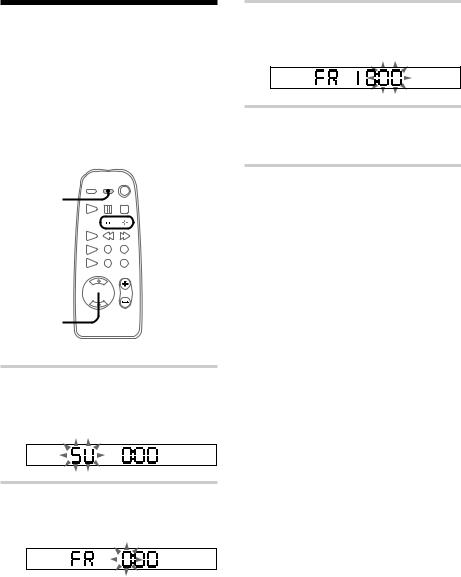
Step 2: Setting the time
You must set the time before you can use the timer functions.
The clock is on a 24-hour system for the European model, and a 12-hour system for other models.
The 24-hour system model is used for illustration purpose.
Set the time before turning the power on.
DISPLAY



 2,3,4
2,3,4
1


 2,3,4
2,3,4
1 Press TIMER SET while the power is off.
The day indication flashes after “CLOCK SET” flashing.
2 Press +/– to set the day then press ENTER.
The hour indication flashes.
3 Press +/– to set the hour then press ENTER.
The minute indication flashes.
4 Press +/– to set the minute then press ENTER.
The clock starts.
To change the time
You can change the preset time while the power is on.
1Press TIMER SET.
2Press +/– repeatedly until “CLOCK SET” appears then press ENTER.
3Repeat steps 2 to 4.
To show the time
You can display the clock any time.
Press DISPLAY repeatedly until the clock display appears.
Tips
•If you have made a mistake, start over from step 1.
•The built-in clock shows the time in the display while the power is off.
•The upper dot flashes for the first half of a minute (0 to 29 seconds), and the lower dot flashes for the last half of a minute (30 to 59 seconds).
6

Step 3: Presetting radio stations
You can preset the following number of stations:
– 20 for FM, 10 for AM.
|
1 |
2 |
4,6 |
3,4 |
5 |
|
6 |
1 Press ?/1 to turn on the system.
2 Press TUNER/BAND repeatedly until the band you want appears in the display.
Each time you press the button, the band changes as follows:
FM y AM
3 Press TUNING MODE repeatedly until “AUTO” appears.
4 Press +/– (or TUNING +/– on the unit).
The frequency indication changes and scanning stops when the system tunes in a station. “TUNED” and “STEREO” (for a stereo program) appear. When you want to stop scanning, press TUNING MODE.
5 Press MEMORY.
A preset number flashes.
Proceed to step 6 while the preset number is flashing. If the unit is not operated for more than 16 seconds, the preset number disappears and the unit returns to the status of step 3. If this happens, start over from step 4.
6 Press +/– to select the preset number you want then press ENTER.
The station is stored.
Select 1 to 20 for FM, and select 1 to 10 for AM.
7 Repeat steps 2 to 6 to preset other stations.
To tune in the station manually
1Press TUNING MODE repeatedly until “MANUAL” appears in step 3.
2Press +/– (or TUNING +/– on the unit) repeatedly to tune in the station and continue from step 5.
To change the preset number
Start over from step 2.
continued
Started Getting
7
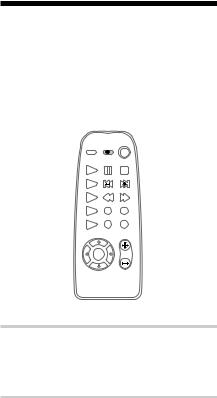
Step 3: Presetting radio stations (continued)
To change the AM tuning interval (except for European model)
The AM tuning interval is factory-set to
9 kHz (10 kHz in some areas). To change the AM tuning interval, tune in any AM station first, then turn off the power. While holding down the TUNING + button, turn the power back on. When you change the interval, all the AM preset stations are erased. To reset the interval, repeat the same procedure.
Tips
•When a new station is memorized, the station formerly memorized at that preset number is erased.
•The preset stations are retained for a week even if you disconnect the AC power cord or if a power failure occurs.
•If noise is heard while listening to an FM station, remove the FM antenna from the rear panel and place the antenna outside the cabinet.
Saving the power in standby mode
You can lower the power consumption to a minimum (Power Saving Mode) and save energy in the standby mode.
 DISPLAY
DISPLAY
,Press DISPLAY when the power is off.
The unit switches to the Power Saving Mode and the clock display disappears.
The system turns on/off by pressing ?/1.
To cancel the Power Saving Mode
Press DISPLAY.
The clock display appears.
Notes
•When the Daily Timer is set, you cannot switch to the Power Saving Mode.
•When the Daily Timer is set in the Power Saving Mode, the Power Saving Mode does not function until the timer is canceled.
8
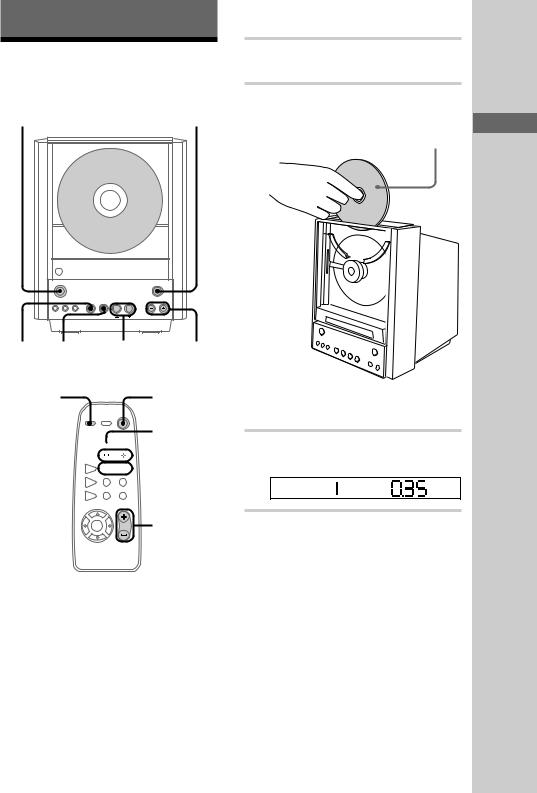
Basic Operations
Playing a CD
To turn on the system, press ?/1.
"/1 (Power) |
1,2 |
|||
|
|
|
|
|
|
|
|
|
|
|
|
|
|
|
|
|
|
|
|
|
?/1 |
Z |
|
|
NX x .m M> |
3 |
x |
./> VOL –/+ |
|
m/M |
|
OPEN/ |
|
"/1(Power) |
CLOSE |
|
|
S
CD H 

 s
s



 l/L
l/L 

 j/J
j/J
1 Touch Z (or press OPEN/CLOSE on the remote) to raise the disc tray.
2 Place a CD vertically in the tray.
With the label side front. When you play a 8 cm CD, use the optional adaptor.
To lower the disc tray, touch Z(or press OPEN/CLOSE on the remote) again.
3 Press NX (or CD Hon the remote).
Play starts.
Operations Basic
VOL +/– |
continued |
9
